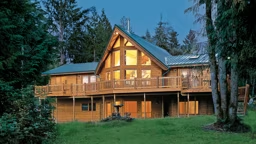Eastern red cedar has taken root in Oklahoma in a very big way, a dangerous way according to farmers, conservationists and land-use experts within the state, and relevant Federal agencies. "In 1955 we began collecting data on the red cedar spreading across the state," U.S. Department of Agriculture state range conservationist Mark Moseley was quoted in September 2003. "At the time we determined the size of the infestation was about one and half million acres. By sometime next year (2004) we anticipate there will be eight million acres of juniper in Oklahoma, with a spread rate of more than 300,000 acres every year or 762 acres per day."
Invasion Upsides
Red cedar infestation is not a problem endemic to Oklahoma, but Planet Earth itself. Experts contend, however, that the resolution of this issue need not entail the expenditure of punitive amounts of monetary and/or labor capital. A more sensible and certainly more lucrative approach has been the conversion of this destructive species from pest to commodity. Much can be made from the humble cedar tree; from shavings for animal bedding and landscape mulch to lumber industry particleboard, and tinder to generate electricity. Log furniture can also be created using this all too abundant natural resource, an option representing one of the very few upsides of the red cedar incursion."Log furniture is primarily constructed of natural harvested un-milled wood," explains Barry Eckhardt, co-founder, AspenLog, a log furniture company in Pine, Co. "Its biggest selling point is authenticity. You get features imposed by nature; bug runs, elk rubs, scarring and other glorious imperfections, and the payback is a handsome, rustic look for which woods such as red and white cedar, aspen and hickory are particularly amenable. Most people in my business shy away from red cedar and materials considered 'pariah woods' by the industry but transformed into fine furniture, they create incredible ambience."
According to Eckhardt, the natural look of log furniture made of cedar, aspen and hickory perfectly compliments any residential setting; be it a suburban ranch, an urban condo or a log cabin tucked deep in the woods of a fishing resort. So-called nuisance woods have stories to tell, he explains, and companies like AspenLog allow them to speak their minds. The Quaking Aspen, for example, is one of Earth's longest-lived organisms, and one of the largest. The species reproduces via a process known as "suckering." The Aspen extends its roots a considerable distance from the main plant, and when the roots emerge from the ground they look just like new trees.
One individual in UT known as "The Pando" is thought to be at least 80,000 years old. Such a geriatric specimen will bear plenty of scars in the form of bug runs, elk rubs; perhaps even a wound inflicted in its younger days by a charging mastodon. "Woods like red cedar, aspen and especially hickory are hard to work with," Eckhardt adds. "But the dividend you receive in the form of gorgeous furniture more than compensates for the labor you invest in its creation. The pieces are elevated to the level of art, not in spite of but because of their rugged, raw, earthy composition, and blemishes.
The furniture we sell has character, bottom line, and we handcraft every piece of it right here in the western United States. The woods from which the products are made tell a story, and it seems to me we should let them do just that. It makes more sense to craft a load of nuisance wood into a fine home accessory than allow it to be mowed down and carted away or rot on some Rocky Mountain slope." AspenLog is one of a growing number of companies to take advantage of the abundance of so-called pariah woods, and the dividends earnable via their use. Word of these benefits is hitting the street through the work of The Aromatic Cedar Association (www.acedar.org), a non-profit based in Oklahoma City dedicated to the promotion of aromatic red cedar as a viable industrial commodity.
"Red cedar has many potential uses, and the list includes not only things like furniture, mulch and wood pellets," says Director Don Queal. "There's also talk of using red cedar to make ethanol. In some avenues we're approaching mature marketing, in others such as biomass for energy we've got quite a long way to go. The point is we've been moving steadily in the right direction, especially over the course of the past three years. We want people to think of red cedar not as junk wood but as a commodity."












